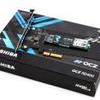Introduction
Toshiba OCZ RD400 PCIe NVME SSD
Performance at a completely new level...
We review the new Toshiba OCZ RD400 PCIe NVME SSD. The product in it's core really is an M.2. SSD placed on a PCIe daughter board. So if you have a properly fast M.2. slot (with four PCIe Gen 3.0 lanes tied to it), you might as well use that one as Toshiba will release these SSDs with and without the PCIe daughter card. Once in use, you do get an amazingly fast storage unit producing breathtaking numbers. We have been closing in at 3 GB/sec read speeds whereas 1.5 GB/sec writes can be considered something normal. Priced aggressively Toshiba seems to have the something special in their hands, and it's all about NVMe. NVMe - is an abbreviation for NVM Express, NVMe, or Non-Volatile Memory Host Controller Interface Specification (NVMHCI) and boils down to the specification for accessing solid-state drives (SSDs) attached through the PCI Express (PCIe) bus. "NVM" is an acronym for non-volatile memory, which is used in SSDs. As a logical device interface, SATA3 might not have been long among us, but the performance of NAND based storage is growing much faster compared to the adoption of SATA ports. Your free PCIe lanes as such are a really fast alternative as it is an interface with much more available bandwidth.
Um Toshiba and not OCZ ?
Yes. Roughly a year or two ago Toshiba purchased OCZ. Up-to April this year OCZ functioned as a separate brand owned by Toshiba, the decision was made to house OCZ as a brand inside Toshiba, hence now you will see what was supposed to be the OCZ RevoDrive 400 is now being marketed as Toshiba OCZ RD400. This new naming extends to the entire range, the OCZ Trion 150 SSD will be named the Toshiba OCZ TR150 and the Vertex 180 the VT180. Back to storage sweetness though as the development rate is going so fast that current component technology cannot keep up with the regular industry pace. We had the transition to SATA 3 (6G) and the minute SATA 3 came out these new 6G controllers already started reaching their maximum bandwidth with the latest generation SSDs which can reach 570 MB/sec already. The latest NVMe PCIe and M.2. products are, simply put, PCIe SSDs that slips into an empty 4x or higher PCIe slot of your PC motherboard (Gen 3.0 preferred), thus breaking away from the SATA3 restrictions. The NAND flash memory is tied to a multi-channel controller. Now shake it, stir it, boil it and boom... a very powerful storage solution will now be throwing silly numbers over the PCI-Express bus, instead of that limiting SATA connector. Though the unit needs a driver, it's bootable as an OS storage unit as well. There are restriction though, but we'll explain that further on-wards in our review. The low-profile PCIe 3.0 ready SSD card promises to deliver a good desktop computing experience with fast application loading times, ultra-fast data access and shorter boot-ups of today’s and future high-end desktops featuring PCIe 4x / 16x interface. Available in capacities of 128GB, 256GB, 512GB and 1 TB the Toshiba OCZ RD40 PCIe NVME SSD can handle a maximum sustained data read speed is of 2,600 MB/s and the top model write speed is at 1,600 MB/s. Meanwhile, the random 4K performance is hovering at 210,000 IOPS (inputs/outputs per second) on reads. Add to that a proper life expectancy with TRIM and Garbage Collection technologies are all supported as well. All in all we'll have quite a bit to talk about (and show you) today, but have a peek at the product being tested today first.
The Toshiba OCZ RD40 PCIe NVME SSD is powered by an in-house Toshiba controller chip sporting the latest 128 Gbit MLC NAND ICs, from Toshiba ICs. There will be a standalone M.2. version as well as the version tested today with PCIe daughter card both are equally fast in performance as ling as your M.2. slot is can be linked at x4 PCIe lanes. We will test the Toshiba OCZ RD400 512 GB model today.
The Toshiba OCZ RD400 PCIe NVME SSD (512GB - SKU code RVD400-M22280-512G-A)

